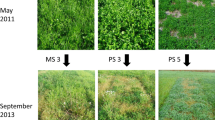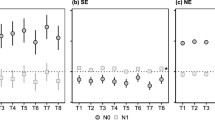Abstract
Six white clover genotypes and eight grass varieties belonging to four different species were grown both in monoculture and as grass-legume binary mixtures in dense swards for two years under a mowing regime and a management including N fertilization. Dry matter yield and yield-related traits were recorded to investigate some aspects of inter-specific interference in white clover-based mixtures and to define a methodology for selecting genotypes of this clover suited to conditions of association. Clover was at a competitive disadvantage in most mixtures. Differences among grasses for aggressiveness were related more to variety vigour than to species. Clover compatibility proved specific only in relation to grass vigour. Variation among clovers for tolerance to competitive stress involved significant cross-over interactions passing from monoculture to severe stress conditions for clover yield and other traits, and was related positively to stolon density and negatively to yield and leaf gigantism traits recorded in monoculture. Clover selection for high levels of competitive stress seems possible either by genotype assessment in stress conditions or by a combination of high yield and stolon density assessed in monoculture.
Similar content being viewed by others
References
Annicchiarico P, Piano E (1993) Performance of white clover genotypes in monoculture and in binary mixtures with two ryegrass varieties. J Genet Breed 47:175–178
Atwood SS, Garber RJ (1942) The evaluation of individual plants of white clover for yielding ability in association with bluegrass. J Am Soc Agric 34:1–6
Austin MP (1990) Community theory and competition in vegetation. In: Grace GB, Tilman D (eds) Perspectives on plant competition. Academic Press, San Diego, pp 215–238
Breese EL, Hill J (1973) Regression analysis of interactions between competing species. Heredity 31:181–200
Collins RP, Rhodes I (1990) The basis and significance of compatibility in grass/clover mixtures. Herba 3:30–32
Davies WE, Tyler BF (1961) The assessment of breeders' material. In: Rep Welsh Pl Breed Stn for 1960, p 31
Dijkstra J, De Vos ALF (1972) The evaluation of selections of white clover (Trifolium repens L.) in monoculture and in mixture with grass. Euphytica 21:432–449
Evans DR, Hill I, Williams TA, Rhodes I (1989) Coexistence and the productivity of white clover-perennial ryegrass mixtures. Theor Appl Genet 77:65–70
Finlay KW, Wilkinson GN (1963) The analysis of adaptation in a plant breeding programme. Aust J Agric Res 14:742–754
Frame J, Newbould P (1986) Agronomy of white clover. Adv Agron 40:1–88
Gail M, Simon R (1985) Testing for qualitative interactions between treatment effects and patient subsets. Biometrics 41:361–372
Harris W (1987) Population dynamics and competition. In: Baker MJ, Williams WM (eds) White clover. CAB International, Wallingford, UK, pp 203–297
Hill J (1980) Plasticity of white clover grown in competition with perennial ryegrass. In: Rep Welsh Pl Breed Stn for 1979, pp 52–54
Hill J (1990) The three Cs — competition, coexistence and coevolution — and their impact on the breeding of forage crop mixtures. Theor Appl Genet 79:168–176
Hill J, Michaelson-Yeates TPT (1987a) Effects of competition upon the productivity of white clover-perennial ryegrass mixtures. Analysis of and interrelations between characters. Plant Breed 98:161–170
Hill J, Michaelson-Yeates TPT (1987b) Effects of competition upon the productivity of white clover-perennial ryegrass mixtures. Seasonal trends. Plant Breed 99:251–262
Jacquard P, Caputa J (1970) Comparaison de trois modèles d'analyse des relations sociales entre espèces végétales. Ann Amélior Plant 20:115–158
Keddy PA (1990) Competitive hierarchies and centrifugal organization in plant communities. In: Grace GB, Tilman D (eds) Perspectives on plant competition. Academic Press, San Diego, pp 266–289
Ledgard SF (1991) Transfer of fixed nitrogen from white clover to associated grasses in swards grazed by dairy cows, estimated using 15N methods. Plant and Soil 131:215–223
Lüscher A, Jacquard P (1991) Coevolution between interspecific plant competitors ?. Tree 6:355–358
Lüscher A, Connolly J, Jacquard P (1992) Neighbour specificity between Lolium perenne and Trifolium repens from a natural pasture. Oecologia 91:404–409
Rhodes I (1991) Progress in white clover breeding. In: White clover development in Europe. FAO, Rome, pp 1–9
Rotili P (1985) Strutture prative binarie. Considerazioni sui dati sperimentali ottenuti a Lodi. Riv di Agron 19:170–177
Thomas RJ (1992) The role of the legume in the nitrogen cycle of productive and sustainable pastures. Grass Forage Sci 47:133–142
Turkington R, Harper JL (1979) The growth, distribution and neighbour relationships of Trifolium repens in a permanent pasture I. Ordination, pattern and contact. J Ecol 67:201–218
Williams WM (1987) Genetics and breeding. In: Baker MJ, Williams WM (eds) White clover. CAB International, Wallingford, UK, pp 343–419
Wit CT de, Van den Bergh JP (1965) Competition between herbage plants. Neth J Agric Sci 13:212–221
Zannone L, Rotili P, Paoletti R, Scotti C (1986) Experimental studies of grass-legume associations. Agronomie 6:931–940
Author information
Authors and Affiliations
Additional information
Communicated by P. M. A. Tigerstedt
Rights and permissions
About this article
Cite this article
Annicchiarico, P., Piano, E. Interference effects in white clover genotypes grown as pure stands and binary mixtures with different grass species and varieties. Theoret. Appl. Genetics 88, 153–158 (1994). https://doi.org/10.1007/BF00225891
Received:
Accepted:
Issue Date:
DOI: https://doi.org/10.1007/BF00225891




